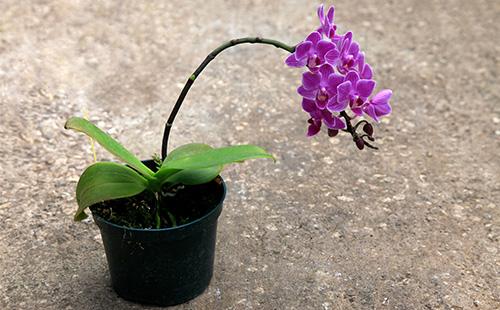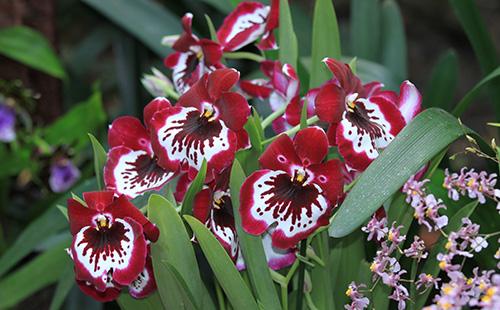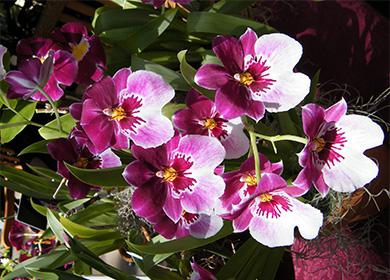The content of the article
Miltonia belongs to the genus Orchid. It grows mainly in Colombia and Brazil, settles in moist, warm forests. Not so long ago, all orchids growing in Central America and Brazil were attributed to the genus miltonia. Then the genus was divided into two families - miltonia and miltoniopsis. The former settle in the lowlands, the latter in the highlands.
Description and Features
Miltonia refers to sympodial epiphytic orchids. This means that in nature it lives on trees, has pronounced aerial roots, forms side shoots with pseudobulbs for self-propagation.
The leaves of miltonia are long, belt-shaped. The color is not characteristic of orchids - a grayish or yellowish hue. Flowers of various colors, sometimes combine several contrasting colors. The petals often flaunt a pattern resembling the wings of butterflies.
Adult miltonia can throw out several peduncles at once, covered with blossoming flowers and buds. Florists are often called miltonia pansies for the similarity of shape and color.
Interesting varieties
In total there are about 20 varieties of miltonia. Not everyone got the spread. Most often, the following types are found in apartments.
- Brilliant. Pseudobulbs are slightly elongated, flattened. Leaves are strap-shaped, yellowish. Quite unpretentious variety - easily withstands heat and cold. Blooms in large white with a yellowish tint. Less common is a pinkish color with purple streaks. Flowering occurs at the end of summer.
- Yellowish.A variety of miltonia hails from Argentina. Pseudobulbs are bifid. On one peduncle, up to 14-15 large flowers bloom. The color is yellowish white, often with a contrasting pattern. Flowering is long - from the beginning of spring to almost autumn.
- Snow-white. A pseudobulb throws one or two peduncles. Up to five flowers bloom on each peduncle. It has a pleasant aroma.
- Renelli. Feature - thin glossy leaves. The flowers are large, white, fragrant. Each peduncle carries up to six flowers. A pink lip with stripes of purple hue is clearly distinguished.
Miltonia Care Features
How to care for miltonia? Like all orchids, miltonia requires special, attentive care. When growing it, you need to adhere to a number of rules.
- Lighting. Compared to other types of orchids, it is less sensitive to the level of lighting. It grows well in bright diffused lighting on window sills. It is easy to put up with a small penumbra - a miltonia can be set slightly away from the window on tables and cabinets. They do not set in the open sun - the leaves get burns, the flowers discolor. In a strong shadow, growth slows down, flowering stops.The pinkish tint of the miltonia leaves indicates that the lighting is selected correctly.
- Temperature. The optimum temperature for growing miltonia is 15-18 ° C in winter and 18-20 ° C in summer. These are recommended but optional parameters. Orchid gradually adapts to the microclimate of the apartment, normally responds to higher temperatures. Miltonia really does not like sudden temperature changes. The room is systematically ventilated, avoiding the formation of drafts.
- Humidity. Dry air, its stagnation are detrimental to miltonia - the leaves dry, the flowers fall off. It is recommended to maintain humidity at 65–80%. A special humidifier is installed near the plant; in winter, batteries are hung with a wet cloth. A good effect is given by spraying the miltonia and the air around it.
- Top dressing. Fertilizer is applied mainly at the stage of laying buds and throughout flowering. Take a special remedy for orchids, the concentration is reduced by half. Contribute every two weeks. Miltonia can be fed in two ways - by watering under the root or by spraying the leaves. A good effect is the alternation of these two methods.
- The soil. Miltonia needs a special primer. It is composed of crushed bark of coniferous trees, fern root and peat. For looseness add 5-10% of the foam. You can use special primers for orchid.
- Transfer. Miltonia does not like unnecessary interventions - they try not to disturb the flower without the need. Miltonia can be transplanted if the roots make their way through the drainage holes or the soil is caked, turned into dust. When transplanting, the root system is carefully inspected, released from the remnants of the old soil mixture. Too long roots are cut, diseased and dried out. All sections are treated with carbon powder.
- Capacity for landing. A large pot is not needed - miltonia prefers light crowding. Unlike phalaenopsis, it is not necessary to use a transparent pot.
Watering
Miltonia is abundantly watered only in the warm season, when it grows intensively and blooms. Excessive watering is avoided. Miltonia should be watered so that the substrate always remains wet. Drying and stagnation of moisture are equally fatal. Two watering methods are used.
- Immersion. The most common watering method. The pot is put in a basin with a little warm water. The liquid should not fall onto the substrate - water is poured into the basin just below the edge of the pot. Keep in water until the substrate is completely saturated with moisture. Usually enough for 15-20 minutes. They take out the pot, put it on the grate to drain excess liquid and return the plant to its place.
- Top watering. Miltonia is watered from a warm shower, imitating tropical rain. The optimum water temperature is 30-40 ° C. After the shower, the flower is dried, the remaining moisture is removed from the axils of the leaves.
Flowering and dormant period
With good care, miltonia blooms twice a year. At the same time, the plant produces up to three peduncles with fragrant large flowers. Each hybrid miltonia variety is characterized by its own shade and pattern.
Flowering lasts up to two months. Proper care of miltonia during flowering allows you to see new peduncles on the plant after a couple of months of rest.During flowering, they try not to disturb the miltonia unnecessarily, regularly apply fertilizers. Protect from the direct sun, try to maintain constant microclimate parameters.
Peduncles are cut immediately after wilting. They cut almost under the root, without injuring the pseudobulb. Within two months, the orchid will rest. Miltonia is transferred to cool, reduce watering. After the appearance of new peduncles, they return to standard care.
The subtleties of reproduction
Children in miltonia are formed extremely rarely, pseudobulbs take root poorly, therefore they propagate it only by dividing the bush. Share the bush at the same time as the transplant. The flower at the time of division must be adult, healthy and have at least six pseudobulbs. The division is carried out in four stages.
- Miltonia is removed from the pot, residual soil is removed from the roots.
- A bush is cut with a sharp sterile knife. Three pseudobulbs and a formed root system are left on each dividend. Slices are treated with carbon powder.
- Delenki left to dry for five hours, then they can be planted in separate pots. The roots are not deepened too much - this is fraught with the development of rot.
- In the first three weeks adhere to moderate watering. A moderate increase in miltonia in the first weeks after division is normal.

Fertilizers for miltonia
Complex mineral fertilizers contain a certain set of micro and macro elements in different concentrations. Each of these substances is responsible for certain processes. A lack or excess of that is reflected in the appearance of the plant, the intensity of flowering and growth. In the table you can find all the substances vital for miltonia, their role in the life of a flower, signs of deficiency or excess.
Table - Substances required by miltonia
| Substance | Its functions | a lack of | Excess |
|---|---|---|---|
| Nitrogen | - Synthesis of protein compounds; - active growth | - Shredding, lethargy of leaves; - yellow, marble leaves; - accelerated drying of old foliage | - Very fast growth; - lack of flowering; - softening and the appearance of cracks on the fabric |
| Phosphorus | - Regulation of cell division; - flowering; - seed ripening | - weakening of the plant; - the curvature of young shoots; - fading, reddish tint of leaves; - lack of flowering | - Blackening the tips of the foliage |
| Potassium | - Metabolism; - photosynthesis; - saturation of cells with moisture; - plant immunity | - General weakening; - growth arrest; - decrease in turgor; - dark green leaves with a yellowish edging; - marbling | - Nitrogen blockage (nitrogen deficiency) |
| Calcium | - cell division; - root formation | - Weakening plant tissue | - Deformation of new shoots |
| Magnesium | - Production of chlorophyll; - adjustment of water intake | - Yellow, blackening spots over time | - Potassium deficiency |
| Iron | - Photosynthesis; - conversion of nitrogen into an easy-to-digest form | - Yellowing veins of young leaves; - spots on the leaves (veins are not affected); - death of leaves from the edges; - slow growth | - Slow development; - lack of flowering |
| Zinc | - Synthesis of enzymes and chlorophyll | - In practice, not identified | - Marble leaves; - inhibition in development; - lack of flowering; - leaf deformation |
| Copper | - The formation of enzymes; - increase immunity | - The curvature of the leaves; - lack of flowering | - Slowdown of growth; - reddish shade of leaves |
Common Care Mistakes
Growing any orchid is a complex process that requires certain knowledge and skills. Beginners often make mistakes that lead to diseases, loss of decorative flower. Information from the table will help determine what happened to miltonia.
Table - Consequences of improper care for miltonia
| A problem | Probable cause |
|---|---|
| Unopened buds fall | - Cold draft; - heat; - dry air |
| Flowering becomes short | - Short rest period; - lack of nutrients; - heat; - action of the open sun |
| Miltonia leaves turn yellow | - Lack or excess of nutrients; - decay of the root system |
| Black spots appear on pseudobulbs and leaves | - Regular waterlogging of the substrate in combination with cold or drafts |
| Leaves turn pale | - lack of nutrients; - excess light |
| The leaves are getting dark | - low light |
| Leaves wither, wrinkle | - A narrow pot; - irregular watering |
| Small black spots appear | - stagnant water |
| Light translucent spots appear | - Sunburn |
| The tips of the leaves dry | - Salinization of soil; - dry air |
Major diseases
With good care, diseases are not very common. The smallest errors of care weaken the miltonia, make it susceptible to fungi and viruses. The table summarizes the main diseases that gardeners have to deal with, as well as their symptoms and treatment.
Table - The main diseases of miltonia
| Disease name | External manifestations | Treatment methods |
|---|---|---|
| Leaf spotting | - Elongated spots of yellow, browning over time | - Not subject to treatment (destroy) |
| Leaf bronze | - Deformation of the leaves; - ugliness; - brown, randomly located spots | - Not subject to treatment (destroy) |
| Rot of the base of the stem | - Whitening and rot of a pseudobulb | - Patient pseudobulbs are removed; - cut out the diseased areas, treat the sections with carbon powder and fungicide; - transplanted |
| Fusarium rot | - Fading and yellowing of individual leaves; - whitish with a pink tint plaque on the root neck | - Transplanted with cutting out damaged areas; - repeatedly treated with fungicides |
| Anthracnose | - Dark sunken spots | - Cut the affected areas; - treated with fungicides; - temporarily lower air humidity |
| Leaf spotting | - Black-brown spots of small size; - yellowing of leaves | - Cut the diseased parts of the plant; - dry and transplant miltonia |
| Gray rot | - Flowers are covered with specks; - softness and wateriness of tissues; - moldy gray coating | - Remove the affected areas; - temporarily reduce humidity - treated with fungicides |
| Bacterial rot | - Fade and rotting leaves | Not subject to treatment (destroy) |
| Late blight | - Withering and drying of individual parts of the plant; - rot from the base of the stem | - Cut out diseased areas and treat with fungicides (the probability of recovery is very low) |
| Root rot | - Haze and pale color of leaves; - softening, rotting of the roots; - "frayed" roots | - Transplanted with the removal of the affected parts; - reduce watering; - repeatedly treated with fungicides |
| Brown rot (Only young plants under the age of several weeks are affected) | - Thinning, browning of the base of the stem | - Not subject to treatment (destroy) |
| Cercosporosis | - Yellow spots on the edge of the back side of the sheet; - the addition of black, purple, red-brown spots; - falling of sick leaves | - Affected leaves are removed; - limit watering; - reduce air humidity; - sprayed with fungicide "Mancozeb" |

Typical pests
Miltonia is attacked by the same pests as the rest of the orchid species. Dry air provokes their appearance, proximity to infected plants, violation of care conditions. Most of them feed on plant sap, which leads to its weakening. Information on the main pests and methods of combating them is given in the table.
Table - The main pests of miltonia
| Pest | How to detect | What to do |
|---|---|---|
| Thrips | - Uneven yellowish-white color of individual sections of leaves; - isolation of insects in the form of dark dots; - drying and falling of leaves; - dried spots on the edges of the petals | - Multiple treatment with “Aktara”, “Fufanon”, “Iskra”, “Tanrek” preparations |
| Spider mite | - Yellow specks; - large faded areas; - spider web on the back of the leaves | - Treatment with soapy water or mineral oil; - increase in humidity; - treatment with acaricides "Akarin", "Vermitek", "Lightning" |
| Shields | - Light spots on the leaves; - insects in brown shields; - transparent adhesive coating; - secondary attachment of soot fungus | - Lubrication of areas with insects with vegetable oil; - manual removal of insects; - treatment with Actellik or Karbofos |
| Worms | - Waxy discharge on petioles and veins | - Spraying with mineral oil |
| Aphids | - Sticky discharge; - twisting and yellowing of young leaves | - Washing with soapy water; - spraying with infusion of tobacco dust or any insecticide |
If the roots rotted ...
Rotting of the roots is a problem not only of miltonia, but also of other types of orchids. It so happens that the plant remains completely without roots. What to do in such cases? Is it possible to save miltonia? The method for resuscitation of the roots of miltonia is described step by step below. Proceed in five steps.
- Remove the orchid from the pot, remove any rotten roots.
- For 10 minutes, dip the miltonia outlet into a 2% solution of any fungicide.
- Sprinkle all sections with coal powder or crushed chalk, leave to dry for five hours.
- Fill the container with warm water. Set the miltonia into it for 6 hours. No need to immerse the flower in water completely - only its base should touch the liquid.
- After six hours, remove the miltonia and let it dry until the next morning.
This procedure must be repeated every morning until the length of the young roots reaches 4-5 cm. After the roots grow back, the resuscitated miltonia is transplanted into the ground.
Growing miltonia at home is an excellent choice for beginners who have not yet had to deal with orchids. Compared to most types of orchids, miltonia is characterized by comparative unpretentiousness, resistance to diseases and pests.

